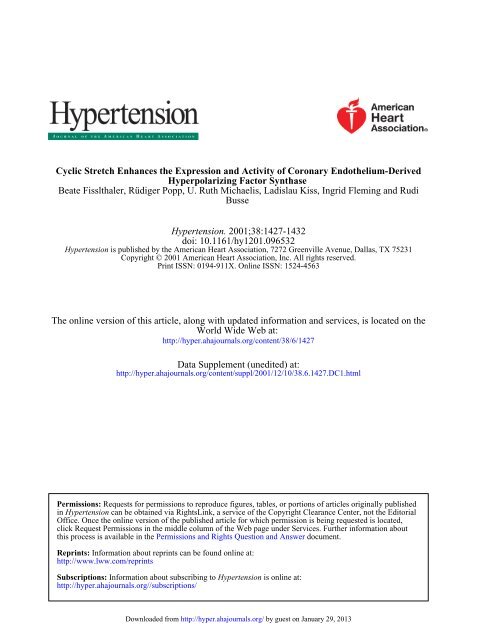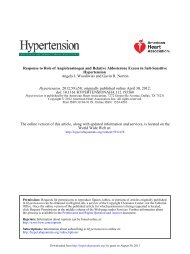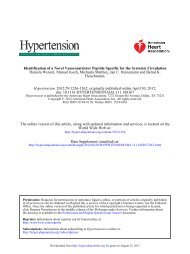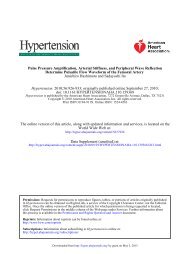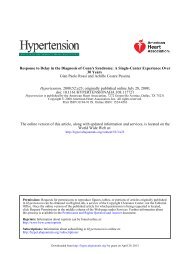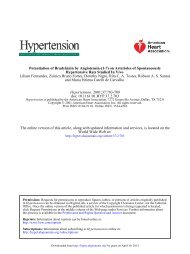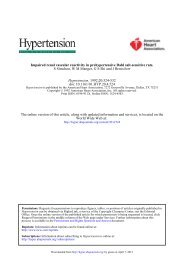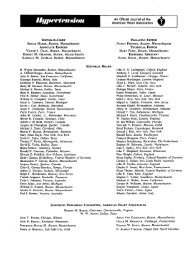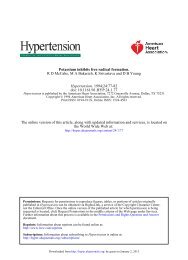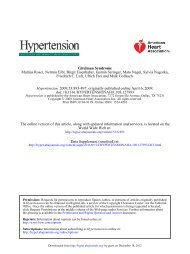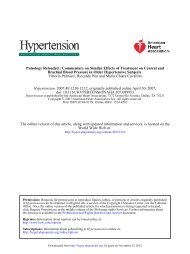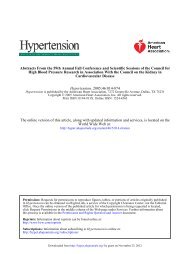Busse Beate Fisslthaler, Rüdiger Popp, U. Ruth ... - Hypertension
Busse Beate Fisslthaler, Rüdiger Popp, U. Ruth ... - Hypertension
Busse Beate Fisslthaler, Rüdiger Popp, U. Ruth ... - Hypertension
You also want an ePaper? Increase the reach of your titles
YUMPU automatically turns print PDFs into web optimized ePapers that Google loves.
Cyclic Stretch Enhances the Expression and Activity of Coronary Endothelium-Derived<br />
Hyperpolarizing Factor Synthase<br />
<strong>Beate</strong> <strong>Fisslthaler</strong>, <strong>Rüdiger</strong> <strong>Popp</strong>, U. <strong>Ruth</strong> Michaelis, Ladislau Kiss, Ingrid Fleming and Rudi<br />
<strong>Busse</strong><br />
<strong>Hypertension</strong>. 2001;38:1427-1432<br />
doi: 10.1161/hy1201.096532<br />
<strong>Hypertension</strong> is published by the American Heart Association, 7272 Greenville Avenue, Dallas, TX 75231<br />
Copyright © 2001 American Heart Association, Inc. All rights reserved.<br />
Print ISSN: 0194-911X. Online ISSN: 1524-4563<br />
The online version of this article, along with updated information and services, is located on the<br />
World Wide Web at:<br />
http://hyper.ahajournals.org/content/38/6/1427<br />
Data Supplement (unedited) at:<br />
http://hyper.ahajournals.org/content/suppl/2001/12/10/38.6.1427.DC1.html<br />
Permissions: Requests for permissions to reproduce figures, tables, or portions of articles originally published<br />
in <strong>Hypertension</strong> can be obtained via RightsLink, a service of the Copyright Clearance Center, not the Editorial<br />
Office. Once the online version of the published article for which permission is being requested is located,<br />
click Request Permissions in the middle column of the Web page under Services. Further information about<br />
this process is available in the Permissions and Rights Question and Answer document.<br />
Reprints: Information about reprints can be found online at:<br />
http://www.lww.com/reprints<br />
Subscriptions: Information about subscribing to <strong>Hypertension</strong> is online at:<br />
http://hyper.ahajournals.org//subscriptions/<br />
Downloaded from<br />
http://hyper.ahajournals.org/ by guest on January 29, 2013
Cyclic Stretch Enhances the Expression and Activity<br />
of Coronary Endothelium-Derived Hyperpolarizing<br />
Factor Synthase<br />
<strong>Beate</strong> <strong>Fisslthaler</strong>, <strong>Rüdiger</strong> <strong>Popp</strong>, U. <strong>Ruth</strong> Michaelis, Ladislau Kiss, Ingrid Fleming, Rudi <strong>Busse</strong><br />
Abstract—Endothelium-derived hyperpolarizing factor (EDHF) mediates NO/prostacyclin-independent relaxation in the<br />
coronary circulation. Because hemodynamic stimuli modulate endothelial gene expression and because coronary arteries<br />
are subjected to pronounced variations in vessel distension, we determined the effects of cyclic stretch on the expression<br />
and activity of the coronary EDHF synthase/cytochrome P450 (CYP) 2C8/9. In cultured porcine coronary and human<br />
umbilical vein endothelial cells, acute application of cyclic stretch (6%, 1 Hz, 10 minutes) elicited the generation of<br />
8,9-epoxyeicosatrienoic acid (EET), 11,12-EET, and 14,15-EET. Prolonged stretch (4 to 36 hours) increased the<br />
expression of CYP 2C mRNA and protein 5- to 10-fold and was accompanied by a 4- to 8-fold increase in EET<br />
generation. A corresponding increase in CYP 2C mRNA and protein was also observed in pressurized segments of<br />
porcine coronary artery perfused under pulsatile conditions (8%, 1 Hz) for 6 hours. Although in cultured endothelial<br />
cells, cyclic stretch elicited the rapid activation of tyrosine kinases as well as Akt and the p38 mitogen-activated protein<br />
kinase, the mechanism by which cyclic stretch induces the expression of CYP 2C could not be elucidated, because<br />
inhibitors of these pathways induced CYP 2C expression in cells maintained under static conditions. These results have<br />
identified coronary EDHF synthase/CYP 2C as a novel mechanosensitive gene product in native and cultured<br />
endothelial cells. Because this enzyme generates both EETs and superoxide anions, this finding has wide-reaching<br />
implications for vascular homeostasis in conditions of manifest endothelial dysfunction. (<strong>Hypertension</strong>. 2001;38:1427-<br />
1432.)<br />
Key Words: endothelium-derived factor � cytochrome P450 � arteries � inositol � protein kinases<br />
Humoral stimuli acutely modulate local blood flow by<br />
eliciting the production and release of vasoactive autacoids<br />
from the endothelium, such as NO, prostacyclin (PGI2), � endothelin-1, prostaglandin H2, and superoxide anions (O2 ).<br />
However, hemodynamic stimuli such as fluid shear stress and<br />
pulsatile stretch, to which the endothelial lining of blood<br />
vessels is continually subjected, are the physiologically most<br />
important determinants of the continuous production of these<br />
autacoids in vivo. 1 In several vascular beds, an endotheliumderived<br />
hyperpolarizing factor (EDHF) represents a third<br />
endothelial vasodilator that mediates NO/PGI2-independent relaxation. Several different EDHFs are now known to exist<br />
in different species, but the hyperpolarizing factor produced<br />
by coronary and renal arteries from humans, pigs, cows, dogs,<br />
rats, and rabbits displays characteristics similar to those of an<br />
epoxyeicosatrienoic acid (EET) generated from arachidonic<br />
acid by a cytochrome P450 (CYP) epoxygenase. 2<br />
Pulsatile changes in transmural pressure, causing simultaneous<br />
vessel distension, enhance the production of EDHFs/<br />
EETs by native porcine coronary endothelial cells, and with<br />
the use of a patch-clamp bioassay system, it could be<br />
demonstrated that such rhythmic changes in arterial diameter<br />
evoke the generation of a CYP inhibitor–sensitive EDHF. 3<br />
Because cyclic stretch elicits the production of a hyperpolarizing<br />
factor from porcine coronary arteries 3 and because a<br />
CYP 2C epoxygenase homologous to CYP 2C8/9 was recently<br />
identified as a putative coronary EDHF synthase, 4 we<br />
sought to determine whether this hemodynamic stimulus<br />
modulates the expression and activity of CYP 2C.<br />
Methods<br />
Cell Culture<br />
Porcine coronary artery endothelial cells and human umbilical vein<br />
endothelial cells were prepared as described 5 and seeded on flexiblebottomed<br />
6-well culture plates coated with pronectin (BioFlex,<br />
Flexcell International Corp). After they reached confluence, the cells<br />
were mounted onto loading plates in a FlexerCell FX-3000 strain<br />
unit (Flexcell) and placed in an incubator. Cells were stretched with<br />
an average strain of 6% at a rate of 1 Hz, and static control<br />
experiments were performed on cells on stretch plates not exposed to<br />
cyclic strain. After stimulation, endothelial cells were harvested, and<br />
CYP-derived eicosanoids were determined as described. 4<br />
Received April 28, 2001; first decision June 18, 2001; revision accepted June 26, 2001.<br />
From the Institut für Kardiovaskuläre Physiologie, Klinikum der J.W.G.-Universität (B.F., R.P., U.R.M., I.F., R.B.), Frankfurt am Main, Germany; and<br />
Zentrum der Inneren Medizin, Justus Liebig Universität Gießen (L.K.), Gießen, Germany.<br />
Correspondence to Dr Ingrid Fleming, Institut für Kardiovaskuläre Physiologie, Klinikum der J.W.G.-Universität, Theodor-Stern-Kai 7, D-60590<br />
Frankfurt am Main, Germany. E-mail fleming@em.uni-frankfurt.de<br />
© 2001 American Heart Association, Inc.<br />
<strong>Hypertension</strong> is available at http://www.hypertensionaha.org<br />
Downloaded from<br />
http://hyper.ahajournals.org/ 1427 by guest on January 29, 2013
1428 <strong>Hypertension</strong> December 2001<br />
Cyclic Stretch of Porcine Coronary<br />
Artery Segments<br />
Porcine epicardial artery segments (length �40 mm, mean external<br />
diameter 2.4 to 2.8 mm) were excised and cut into 2 segments of<br />
equal length. The segments were cannulated at both ends and placed<br />
into vessel chambers in which perfusion pressure was continuously<br />
monitored. Vessels were pressurized to 40 to 60 mm Hg and<br />
perfused (1 mL/min) with minimum essential medium. After stabilization,<br />
sinusoidal pressure changes (30 to 40 mm Hg, 1 Hz), were<br />
applied to 1 of the coronary artery pairs. The diameter changes<br />
induced corresponded to a calculated strain of between 6% and 8%.<br />
Isolation of RNA and RT-PCR<br />
Total RNA was isolated from cultured coronary endothelial cells or<br />
coronary arterial segments by intraluminal incubation with either<br />
dispase (2.4 U/mL) or guanidine isothiocyanate. Random hexanucleotide<br />
primers were used for reverse transcription (RT) of equal<br />
amounts of RNA, and the oligonucleotides used for polymerase<br />
chain reaction (PCR) were derived from a porcine CYP 2C34<br />
sequence that exhibits a high homology to the human 2C8/9<br />
sequence, as described. 6 In some experiments, the expression of CYP<br />
3A, CYP 2J, and the endothelial NO synthase (eNOS) was determined.<br />
Elongation factor-2 (EF-2) served as an internal control for<br />
cultured endothelial cells, whereas platelet and endothelial cell<br />
adhesion molecule-1 (DECAM-1) was used as a control for porcine<br />
coronary arteries (for primers, see online data supplement available<br />
at http://www.hypertensionaha.org). For the verification of the DNA<br />
fragment, the PCR products were transferred to nylon membranes<br />
and hybridized with 32 P-labeled DNA fragments derived from a<br />
plasmid containing the coding sequence of CYP 2C8.<br />
Immunofluorescence Experiments<br />
In some experiments, cells or arterial segments were fixed with<br />
formaldehyde and permeabilized with Triton X-100 (0.2% [vol/<br />
vol]), and the segments were incubated with a specific CYP 2C<br />
antibody (kindly provided by Dr E. Morgan, Emory University,<br />
Atlanta, Ga) or antibodies recognizing actin (Sigma), Akt/protein<br />
kinase B (PKB) (Cell Signaling), or phosphotyrosine (Transduction<br />
Laboratories), as described. 7<br />
Statistical Analysis<br />
Data are expressed as mean�SEM, and statistical evaluation was<br />
performed by using the Student’s t test for paired or unpaired data,<br />
1-way ANOVA followed by a Bonferroni t test, or ANOVA for<br />
repeated measures, where appropriate. Values of P�0.05 were<br />
considered statistically significant.<br />
Results<br />
Acute Effect of Cyclic Stretch on the Generation<br />
of EETs by Coronary Endothelial Cells<br />
In unstimulated endothelial cells, free arachidonic acid<br />
(13.5�1.8 ng per well) and small amounts of 5,6-, 8,9-,<br />
11,12-, and 14,15-EET were detected. Cyclic strain (6%, 1<br />
Hz, 10 minutes) slightly enhanced the liberation of arachidonic<br />
acid (to 17.6�1.6 ng per well) as well as the generation<br />
of EETs (Figure 1). Although stretch enhanced the production<br />
of all the regioisomers detected, the most pronounced effects<br />
were on the generation of 11,12- and 14,15-EET. To enhance<br />
endothelial CYP expression, some cell batches were incubated<br />
with the Ca2� antagonist nifedipine. As previously<br />
reported, 6 nifedipine (0.1 �mol/L, 18 hours) enhanced the<br />
expression of CYP 2C protein by �3-fold (data not shown).<br />
In these cells, the amount of free arachidonic acid was<br />
virtually unchanged (23.1�8.1 versus 38.3�8.7 ng per well,<br />
n�3, P�NS), whereas the basal generation of EETs was<br />
Figure 1. Effect of cyclic strain (6%, 1 Hz, 10 minutes; hatched<br />
bars) on the acute generation of the 4 regioisomers of EET (5,6-<br />
EET, 8,9-EET, 11,12-EET, and 14,15-EET) by coronary artery<br />
endothelial cells. Open bars indicate the static condition. Experiments<br />
were performed in cells preincubated with either solvent<br />
(culture medium) or nifedipine (0.1 �mol/L, 18 hours). The<br />
results are expressed either as the median of 3 or the<br />
mean�SEM of 4 separate experiments. *P�0.05 vs static.<br />
greater than that detected in solvent-treated cells. In contrast<br />
to solvent-treated cells, nifedipine-treated cells produced<br />
greater amounts of 5,6- and 8,9-EET, findings that may<br />
indicate that in addition to CYP 2C, nifedipine enhances the<br />
expression of at least 1 additional CYP enzyme, with a profile<br />
of EET generation slightly different from that of CYP 2C8/9.<br />
In nifedipine-treated cells, cyclic stretch enhanced only the<br />
production of 11,12- and 14,15-EET, although the effect was<br />
no longer statistically significant (Figure 1).<br />
Effect of Cyclic Stretch on the Expression of CYP<br />
2C in Cultured Endothelial Cells<br />
Low levels of CYP 2C mRNA were expressed in porcine<br />
coronary endothelial cells cultured under static conditions.<br />
Cyclic stretch time-dependently increased the expression of<br />
CYP 2C, an effect that was first evident after 4 to 8 hours and<br />
was highly significant after 18 to 24 hours (Figure 2). CYP<br />
2C mRNA was maintained at an elevated level (�10-fold<br />
greater than in unstimulated endothelial cells) as long as the<br />
stimulus was applied (maximally, 36 hours). In the same<br />
experiments, cyclic stretch did not significantly affect the<br />
expression of either CYP 3A, CYP 2J, or eNOS mRNA<br />
(Figure 2).<br />
In primary cultures of porcine coronary endothelial cells,<br />
immunofluorescence experiments revealed that not all endothelial<br />
cells expressed CYP 2C. When present, the enzyme<br />
was generally localized to a perinuclear region (Figure 3).<br />
Exposing these cells to cyclic stretch increased the overall<br />
intensity of the signal as well as the number of positively<br />
stained cells.<br />
Human umbilical vein endothelial cells express markedly<br />
lower levels of CYP 2C protein than coronary endothelial<br />
cells, but the expression of CYP mRNA and protein was also<br />
significantly increased by exposure to cyclic stretch over 9 to<br />
18 hours (Figure 4).<br />
Chronic Effect of Cyclic Stretch on the Generation<br />
of EETs by Coronary Endothelial Cells<br />
The increased expression of CYP 2C was accompanied by an<br />
increase in endothelial EET production (Figure 5). Stimulation<br />
of endothelial cells with ionomycin to elevate intracel-<br />
Downloaded from<br />
http://hyper.ahajournals.org/ by guest on January 29, 2013
Figure 2. Effect of stretch on the expression of CYP 2C mRNA<br />
in cultured endothelial cells. Cultured porcine coronary artery<br />
endothelial cells were either incubated under static conditions or<br />
exposed to cyclic stretch (6%, 1 Hz) for up to 24 hours. Total<br />
RNA was isolated for RT-PCR, and CYP 2C, CYP 2J, CYP 3A,<br />
eNOS, and EF-2 PCR products were detected as described in<br />
the text. The bar graph provides a statistical summary of the<br />
data obtained in 4 separate experiments. *P�0.05 vs control.<br />
lular Ca 2� and activate phospholipase A 2 enhanced the production<br />
of these 3 regioisomers 2- to 3-fold (Figure 5). Exposure to<br />
cyclic stretch (6%, 1 Hz) for 18 hours increased the generation<br />
Figure 3. Effect of prolonged cyclic stretch on the expression of<br />
CYP 2C protein in cultured porcine endothelial cells. A, Immunohistochemical<br />
staining of CYP 2C in porcine coronary endothelial<br />
cells maintained under static conditions and after exposure<br />
to cyclic stretch (6%, 1 Hz). The results presented are<br />
representative of data obtained in 3 further experiments, and the<br />
bar represents 20 �m. B, The bar graph shows the changes in<br />
CYP 2C staining between static cultures and cells stretched for<br />
18 hours as pixel intensity/mm 2 after nomalization of the control<br />
group to 100%. *P�0.05 vs control.<br />
<strong>Fisslthaler</strong> et al Cyclic Stretch and Endothelial CYP 2C Expression 1429<br />
Figure 4. Effect of prolonged cyclic stretch on the expression of<br />
CYP 2C protein and mRNA in cultured human endothelial cells.<br />
A, Immunohistochemical staining of CYP 2C in human umbilical<br />
vein endothelial cells after incubation under static conditions<br />
and after exposure to cyclic stretch (6%, 1 Hz). The results presented<br />
are representative of data obtained in 3 further experiments,<br />
and the bar represents 20 �m. B, Confluent cultures of<br />
human endothelial cells were either maintained under static conditions<br />
(time 0) or exposed to cyclic stretch (6%, 1 Hz). Thereafter,<br />
total RNA was isolated for RT-PCR as described in the text,<br />
and in each experiment, a negative control (nc, no reverse transcriptase<br />
in the RT reaction) was included. The results presented<br />
are representative of data obtained in 2 further experiments.<br />
of 11,12-EET and 14,15-EET by 4-fold and induced an 8-fold<br />
increase in 8,9-EET production. Subsequent treatment of these<br />
stretch-conditioned cells with ionomycin did not significantly<br />
increase EET production (Figure 5).<br />
Effect of Cyclic Stretch on the Expression of CYP<br />
2C in Native Endothelial Cells<br />
In porcine coronary artery segments, CYP 2C9 is expressed<br />
exclusively in the endothelial cell layer (Figure 6). No CYP<br />
2C immunostaining was detected in either smooth muscle<br />
cells or in the adventitia. Exposure of coronary segments to<br />
cyclic stretch (�8%, 1 Hz) for 6 hours markedly increased<br />
the CYP 2C fluorescent signal compared with that observed<br />
in vessels that were perfused under nonpulsatile conditions<br />
Figure 5. Effect of prolonged cyclic stretch on the generation of<br />
the EET regioisomers by cultured endothelial cells. Porcine coronary<br />
endothelial cells were either maintained under static conditions<br />
or exposed to cyclic stretch (6%, 1 Hz) for 18 hours.<br />
After stimulation, cells were either harvested directly or exposed<br />
to ionomycin (0.1 �mol/L, 5 minutes). The results are expressed<br />
as the mean�SEM of 3 or 4 separate experiments. *P�0.05 vs<br />
control.<br />
Downloaded from<br />
http://hyper.ahajournals.org/ by guest on January 29, 2013
1430 <strong>Hypertension</strong> December 2001<br />
Figure 6. Effect of cyclic stretch on the expression of CYP 2C in<br />
native endothelial cells. A, Immunohistochemical staining of<br />
CYP 2C (green) and actin (red) in sections of the same porcine<br />
coronary artery after 6-hour incubation under either nonpulsatile<br />
conditions (left) or cyclic stretch (�8%, 1 Hz; right). The results<br />
presented are representative of data obtained in 2 further experiments.<br />
The bar represents 100 �m. B, Paired segments of porcine<br />
coronary artery were perfused under nonpulsatile (static) or<br />
pulsatile conditions (8%, 1 Hz, 6 hours, stretch). Thereafter, total<br />
RNA was isolated for RT-PCR as described in the text, and a<br />
positive control (pc, human liver) and negative control (nc, no<br />
reverse transcriptase in the RT reaction) were included in each<br />
experiment. PECAM-1 indicates platelet and endothelial cell<br />
adhesion molecule-1. The bar graph provides a statistical summary<br />
of the data obtained in 4 separate experiments after normalization<br />
of the control group to 100. *P�0.05 vs control.<br />
(Figure 6). Similarly, CYP 2C mRNA expression was increased<br />
by �5-fold in samples prepared from intact porcine<br />
coronary arteries (Figure 6).<br />
Effect of Kinase Inhibitors on Stretch-Induced<br />
Expression of CYP 2C<br />
In unstimulated endothelial cells, Akt/PKB was distributed<br />
throughout the cytoplasm and in the nucleus. The application<br />
of cyclic stretch induced the time-dependent translocation of<br />
Akt/PKB, so that after 60 minutes of stimulation, the kinase<br />
was exclusively localized to the nucleus (Figure 7). However,<br />
the stretch-induced activation and translocation of Akt/PKB<br />
was unrelated to the increase in CYP 2C expression, inasmuch<br />
as neither wortmannin, a phosphatidylinositol 3-kinase<br />
(PI 3-K) inhibitor, nor rapamycin, an inhibitor of the Akt/<br />
PKB substrate the mammalian target of rapamycin (mTOR),<br />
affected the stretch-induced CYP expression (Figure 7).<br />
Rapamycin also failed to affect the increase in EET generation<br />
induced by cyclic stretch (6%, 1 Hz, 18 hours) (data not<br />
shown).<br />
In unstimulated endothelial cells, immunostaining with a<br />
phosphotyrosine antibody revealed a punctate signal mostly<br />
localized to the cell boundary. In response to cyclic stretch,<br />
the pattern rapidly altered so that the cell-cell boundary was<br />
less intensely labeled, whereas the phosphotyrosine signal in<br />
the nuclear region was markedly increased. The tyrosine<br />
kinase inhibitor herbimycin and the Src inhibitor 4-amino-<br />
5(4-methylphenyl)-7-(t-butyl)phyrazolo[3,4-d]pyrimidine<br />
(PP1) both attenuated the stretch-induced alterations in phosphotyrosine<br />
staining. To determine the effects of tyrosine<br />
kinase inhibition on CYP expression, endothelial cells were<br />
exposed to cyclic stretch in the absence and presence of<br />
herbimycin. As described before, cyclic stretch increased the<br />
expression of CYP 2C protein and mRNA, but herbimycin,<br />
on its own, elicited a much more pronounced effect (Figure<br />
8B and 8C). The signal obtained in response to the combination<br />
of herbimycin and stretch was not different from that<br />
observed with stretch alone.<br />
An additional signaling molecule rapidly activated after the<br />
application of cyclic stretch was the p38 mitogen-activated<br />
protein (MAP) kinase (data not shown). However, it was not<br />
possible to link the activation of this kinase to the stretchinduced<br />
increase in CYP 2C expression, because 2 specific<br />
inhibitors, SB203580 and SB220025, increased CYP 2C<br />
expression under static conditions (by 513�20% and<br />
461�30%, respectively; P�0.01; n�5). None of the kinase<br />
inhibitors used directly affected the activity of isolated<br />
microsomes containing CYP 2C9 (data not shown).<br />
Discussion<br />
In the present study, we have identified an epoxygenase<br />
homologous to CYP 2C8/9 as a novel stretch-inducible<br />
Figure 7. Effect of interfering with the PI 3-K/Akt/mTOR signaling<br />
pathway on the stretch-induced expression of CYP 2C. A,<br />
Immunohistochemical staining of Akt/PKB in porcine coronary<br />
endothelial cells after incubation under static conditions and<br />
after exposure to cyclic stretch (6%, 1 Hz). The results presented<br />
are representative of data obtained in 2 further experiments,<br />
and the bar represents 20 �m. B, Cultured coronary endothelial<br />
cells were either maintained under static conditions (S) or<br />
exposed to cyclic stretch (C; 6%, 1 Hz, 18 hours) in the<br />
absence and presence of wortmannin (Wort, 20 nmol/L) and<br />
rapamycin (Rapa, 100 nmol/L). Thereafter, RNA was isolated for<br />
RT-PCR as described, and CYP 2C PCR products were<br />
detected by Southern blotting and hybridization with isoformspecific<br />
DNA fragments. To ensure that equal amounts of cDNA<br />
were amplified per PCR reaction, PCR for EF-2 was performed.<br />
The results presented are representative of data obtained in 2<br />
further experiments.<br />
Downloaded from<br />
http://hyper.ahajournals.org/ by guest on January 29, 2013
Figure 8. Effect of tyrosine kinase inhibitors on the stretchinduced<br />
tyrosine phosphorylation of endothelial cells and the<br />
expression of CYP 2C. A and B, Immunohistochemical staining<br />
of tyrosine-phosphorylated proteins (A) and CYP 2C (B) in porcine<br />
coronary endothelial cells maintained under static conditions<br />
and after exposure to cyclic stretch (6%, 1 Hz) in the<br />
absence and presence of herbimycin (Herbi, 5 �mol/L) and PP1<br />
(10 �mol/L). The results presented are representative of data<br />
obtained in 2 further experiments, and the bar represents 20<br />
�m. C, Cultured coronary endothelial cells were either maintained<br />
under static conditions (S) or exposed to cyclic stretch<br />
(C; 6%, 1 Hz, 18 hours) in the absence and presence of Herbi (5<br />
�mol/L). Thereafter, RNA was isolated for RT-PCR as described.<br />
The results presented are representative of data obtained in 2<br />
further experiments.<br />
protein in native and cultured endothelial cells. The effects of<br />
stretch on CYP 2C appear to be 2-fold, inasmuch as the acute<br />
application of moderate levels of cyclic stretch enhanced<br />
enzyme activity and EET production, whereas chronic stretch<br />
enhanced the expression of CYP 2C mRNA and protein.<br />
Native and cultured endothelial cells express several CYP<br />
isozymes, including the hydroxylases CYP 3A and CYP 2B<br />
and the arachidonic acid epoxygenases CYP 2J and CYP<br />
<strong>Fisslthaler</strong> et al Cyclic Stretch and Endothelial CYP 2C Expression 1431<br />
2C. 4,6,8,9 Of these isozymes, cultured endothelial cells constitutively<br />
express CYP 3A and CYP 2J, whereas CYP 2C<br />
levels are highly variable, and often no signal is detectable<br />
with the use of RT-PCR. For example, although native<br />
porcine coronary artery endothelial cells clearly express CYP<br />
2C protein, CYP 2C mRNA and protein are barely detectable<br />
in primary cultures of these cells when maintained under<br />
static conditions. 4,6 Because pulsatile stretch has been reported<br />
to activate the EDHF synthase/CYP 2C in porcine<br />
coronary arteries, 3 we postulated that cyclic stretch may<br />
regulate the activity and expression of CYP 2C in a manner<br />
analogous to the regulation of eNOS activity and expression<br />
by fluid shear stress. The results obtained clearly indicate that<br />
cyclic stretch regulates the expression of CYP 2C mRNA and<br />
protein in both native and cultured endothelial cells. Thus, it<br />
is tempting to speculate that cyclic stretch maintains the<br />
expression of EDHF synthase in vivo and that its decreased<br />
expression in vitro is attributable to the lack of this continuous<br />
hemodynamic stimulus. Although endotheliumdependent<br />
hyperpolarization of coronary artery smooth muscle<br />
cells was not investigated in the present study, we have<br />
previously demonstrated that the generation of EETs by<br />
endothelial cells pretreated with either nifedipine 6 or<br />
�-naphthoflavone, 4 which were similar to those measured in<br />
stretch-stimulated endothelial cells, was sufficient to potentiate<br />
the endothelium-dependent hyperpolarization of porcine<br />
coronary artery smooth muscle cells.<br />
The application of cyclic stretch to a variety of different<br />
cells is reported to activate numerous signal transduction<br />
cascades, including the Janus kinase/signal transducer(s) and<br />
activator(s) of transcription 10 and Ras/Raf/extracellular signal–regulated<br />
kinase 1/2 pathways, 11 as well as the epidermal<br />
growth factor receptor tyrosine kinase, 12 the c-Jun NH 2terminal,<br />
11 and p38 MAP kinases. 12 The mechanism by which<br />
pulsatile stretch increases CYP expression in endothelial cells<br />
remains to be fully elucidated. In the present study, we<br />
observed that the PI 3-K/Akt/mTOR signaling pathway was<br />
rapidly activated in stretched endothelial cells, but neither<br />
wortmannin nor rapamycin was found to significantly inhibit<br />
the induction of CYP 2C protein or the stretch-induced<br />
generation of EETs. Additional signaling molecules rapidly<br />
activated after the application of cyclic stretch were tyrosine<br />
kinases and p38 MAP kinase (authors’ unpublished data,<br />
2001). However, it was not possible to link either of these<br />
kinases to the stretch-induced increase in CYP 2C expression.<br />
Part of the difficulty in elucidating the pathway determining<br />
the stretch-induced expression of CYP 2C was due to the fact<br />
that SB203580 and SB220025, 2 specific inhibitors of p38<br />
MAP kinase, and the tyrosine kinase inhibitor herbimycin<br />
enhanced the basal expression of CYP 2C in endothelial cells<br />
maintained under static conditions. However, each of these<br />
inhibitors prevented the stretch-induced activation of the<br />
respective kinases in coronary endothelial cells. Because<br />
many CYP substrates increase the expression of the enzymes<br />
responsible for their metabolism, 13 it is likely that the<br />
pharmacological inhibitors may be at least partially metabolized<br />
by CYP 2C. Indeed, our previous observation, ie, that<br />
the Ca 2� antagonist nifedipine enhances the expression and<br />
the activity of the EDHF synthase/CYP 2C in native and<br />
Downloaded from<br />
http://hyper.ahajournals.org/ by guest on January 29, 2013
1432 <strong>Hypertension</strong> December 2001<br />
cultured endothelial cells, 6 may be attributable to a similar<br />
phenomenon.<br />
The functional consequences of endothelial CYP 2C/<br />
EDHF synthase regulation by cyclic stretch are potentially<br />
wide reaching, because in addition to activating Ca 2� -<br />
dependent K � channels and modulating arterial tone, the<br />
EETs regulate multiple endothelial and smooth muscle signaling<br />
pathways and may promote both endothelial cell<br />
proliferation 14 and angiogenesis. 15 Moreover, EDHF synthase<br />
has recently been shown to generate physiologically relevant<br />
amounts of free radicals, including O 2 �7 ; thus, the activation<br />
of CYP 2C in endothelial cells may participate in the<br />
stretch-induced generation of O 2 � , which has, until now, been<br />
attributed to the activation of NADPH oxidase. 16<br />
Acknowledgments<br />
This work was supported by the Deutsche Forschungsgemeinschaft<br />
(FI 830/1-1) and Institut de Recherches Internationales Servier. The<br />
authors are indebted to Isabel Winter, Stergiani Hauk, and Sina Bätz<br />
for expert technical assistance.<br />
References<br />
1. <strong>Busse</strong> R, Fleming I. Pulsatile stretch and shear stress: physical stimuli<br />
determining the production of endothelium-derived relaxing factors. J<br />
Vasc Res. 1998;35:73–84.<br />
2. Fleming I. Cytochrome P450 2C is an EDHF synthase in coronary<br />
arteries. Trends Cardiovasc Med. 2000;10:166–170.<br />
3. <strong>Popp</strong> R, Fleming I, <strong>Busse</strong> R. Pulsatile stretch elicits the release of the<br />
endothelium-derived hyperpolarizing factor from isolated coronary<br />
arteries: a modulator of arterial compliance. Circ Res. 1998;82:696–703.<br />
4. <strong>Fisslthaler</strong> B, <strong>Popp</strong> R, Kiss L, Potente M, Harder DR, Fleming I, <strong>Busse</strong><br />
R. Cytochrome P450 2C is an EDHF synthase in coronary arteries.<br />
Nature. 1999;401:493–497.<br />
5. <strong>Popp</strong> R, Bauersachs J, Hecker M, Fleming I, <strong>Busse</strong> R. A transferable,<br />
�-naphthoflavone-inducible, hyperpolarizing factor is synthesised by<br />
native and cultured porcine coronary endothelial cells. J Physiol (Lond).<br />
1996;497:3:699–709.<br />
6. <strong>Fisslthaler</strong> B, Hinsch N, Chataigneau T, <strong>Popp</strong> R, Kiss L, <strong>Busse</strong> R,<br />
Fleming I. Nifedipine increases cytochrome P4502C expression and<br />
EDHF-mediated responses in coronary arteries. <strong>Hypertension</strong>. 2000;36:<br />
270–275.<br />
7. Fleming I, Michaelis UR, Bredenkotter D, <strong>Fisslthaler</strong> B, Dehghani F,<br />
Brandes RP, <strong>Busse</strong> R. Endothelium-derived hyperpolarizing factor<br />
synthase (cytochrome P450 2C9) is a functionally significant source of<br />
reactive oxygen species in coronary arteries. Circ Res. 2001;88:44–51.<br />
8. Lin JHC, Kobari Y, Zhu Y, Stemerman MB, Pritchard KA Jr. Human<br />
umbilical vein endothelial cells express P450 2C8 mRNA: cloning of<br />
endothelial P450 epoxygenase. Endothelium. 1996;4:219–229.<br />
9. Node K, Huo Y, Ruan X, Yang B, Spiecker M, Ley K, Zeldin DC, Liao<br />
JK. Anti-inflammatory properties of cytochrome P450 epoxygenasederived<br />
eicosanoids. Science. 1999;285:1276–1279.<br />
10. Pan J, Fukuda K, Saito M, Matsuzaki J, Kodama H, Sano M, Takahashi<br />
T, Kato T, Ogawa S. Mechanical stretch activates the JAK/STAT<br />
pathway in rat cardiomyocytes. Circ Res. 1999;84:1127–1136.<br />
11. MacKenna DA, Dolfi F, Vuori K, Ruoslahti E. Extracellular signalregulated<br />
kinase and c-Jun NH 2-terminal kinase activation by mechanical<br />
stretch is integrin dependent and matrix specific in rat cardiac fibroblasts.<br />
J Clin Invest. 1998;101:301–310.<br />
12. Kudoh S, Komuro I, Hiroi Y, Zou Y, Harada K, Sugaya T, Takekoshi N,<br />
Murakami K, Kadowaki T, Yazaki Y. Mechanical stretch induces hypertrophic<br />
responses in cardiac myocytes of angiotensin II type 1a receptor<br />
knockout mice. J Biol Chem. 1998;273:24037–24043.<br />
13. Guengerich FP. Human cytochrome P450 enzymes. In: Ortiz de<br />
Montellano PR, ed. Cytochrome P450: Structure, Mechanism, and Biochemistry.<br />
New York, NY: Plenum Press; 1995.<br />
14. Fleming I, <strong>Fisslthaler</strong> B, Michaelis UR, Kiss L, <strong>Popp</strong> R, <strong>Busse</strong> R. The<br />
coronary endothelium-derived hyperpolarizing factor (EDHF) stimulates<br />
multiple signalling pathways and proliferation in vascular cells. Pflugers<br />
Arch. 2001;442:511–518..<br />
15. Munzenmaier DH, Harder DR. Cerebral microvascular endothelial cell<br />
tube formation: role of astrocytic epoxyeicosatrienoic acid release. Am J<br />
Physiol. 2000;278:H1163–H1167.<br />
16. Hishikawa K, Oemar BS, Yang ZH, Luscher TF. Pulsatile stretch stimulates<br />
superoxide production and activates nuclear factor-�B in human<br />
coronary smooth muscle. Circ Res. 1997;81:797–803.<br />
Downloaded from<br />
http://hyper.ahajournals.org/ by guest on January 29, 2013


